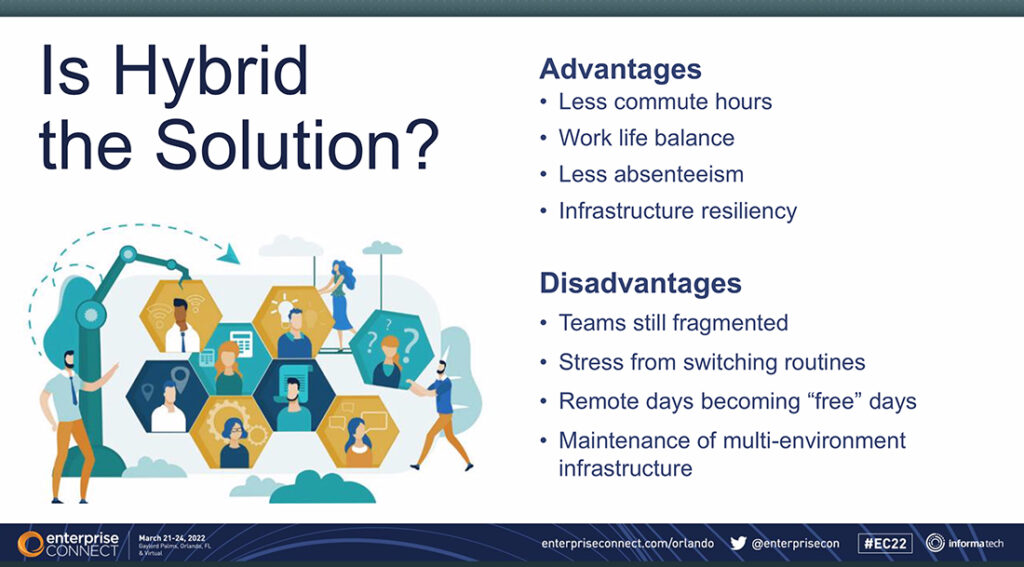Today’s hybrid workplace environment poses multiple challenges for IT leaders, including how best to manage an in-house technology team or provide support to a wide range of end users. In any case, it’s essential to take your company’s culture into account when deploying hybrid office solutions, according to three experts in the field.
“For the workforce, a hybrid approach can mean more flexible schedules, fewer commuting hours and a better work-life balance,” said Robert Lee Harris, president, Communications Advantage, Inc. “But at the same time, teams can become fragmented and you have to manage a multi-environment infrastructure.”
Harris moderated an Enterprise Connect panel discussion on “Company Culture and Your Hybrid-Office Strategy” with panelists Justin Stevens, founder, Ixiom Solutions, and Paula Burgess , vice president of IT, Vecellio Group, a construction company based in West Palm Beach, Florida.
To kick off the conversation, Harris said onboarding and career training and development for knowledge workers were much more challenging in the remote working environment of the last two years. “It can be difficult to mentor younger employees or help them gain visibility across the company,” he said. “In fact, innovation companies had higher attrition rates during the work-from-home period.”
While coming back to the office on a full- or part-time basis can ease some of those issues, a hybrid strategy impacts an organization’s workforce in other ways, Harris said. For instance, employees perceived a hybrid workforce as more stressful than either remote or in-office working, due to the challenge of switching routines from day to day. Another issue that that employees may consider their remote schedules as “free time” and be less engaged with their colleagues.
“You also have to ask if more technology is really the solution,” said Harris. “Do people in your organization really want to be immersed in the screen? Many workers prefer being in the office for the socialization with other people. And don’t forget about the frontline workers who need a very different set of technology tools than office workers.”

Changing leadership roles
IT leaders need to re-assess their roles and priorities in a hybrid workplace, according to Stevens. “Instead of looking over an employee’s shoulder and providing hands-on guidance, leaders need to provide support, including de-stressers during the day,” he said. “You want your team members to feel valued and have a purpose so they are better able to deal with longer workdays and more meetings,” he said.
When looking at the overall organization, IT leaders need to look at specific use cases, as well as company culture when making deployment decisions, Stevens said. “You may also need to redefine the physical workplace and facilities, such as considering open floor plans or reconfiguring the furniture layout,” Stevens said. “Remember that you can’t look a technology in a vacuum. You need to understand and protect the organization’s culture.”
Supporting frontline workers
Communication and cultural issues also come into play when supporting a frontline workforce, said Burgess. “We have about 40 cell-phone-only field employees on construction sites,” she said. “Because those phones get lost from time to time, we make sure we can wipe them remotely.”
Both in-office and field workers can access the company’s Microsoft portal and access applications regardless of device, Burgess said. She noted that employees adopted quickly to using Teams for collaboration on laptops, desktops and mobile devices.
To bring everyone together, Vecellio Group has daily start-up meetings, as well as video conferences to help office workers understand what frontline employees are dealing with in the field, Burgess said. “We also have regular luncheons for both on-site and off-site workers. It’s so important to get together and socialize to maintain that sense of belonging to the company.”
